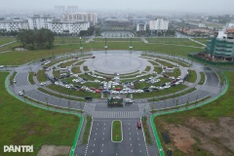
The elevated section of the Nhon - Hanoi station metro line begins commercial operations to serve passengers on August 8, 2024. (Photo: VNA)
According to Conclusion No 174-KL/TU issued on December 4, the Hanoi Party Committee will prioritise the development of public transportation and expedite urban rail network operations.
The initiative is aimed at reducing traffic congestion, improving transportation infrastructure, boosting the city’s socio-economic development and mitigating environmental pollution.
The committee stressed the necessity of formulating a comprehensive investment plan for Hanoi’s urban railway system. This plan aligns with the Politburo’s Resolution No 15-NQ/TW dated May 5, 2022, which outlines the city’s development directions and tasks through 2030, along with other key Politburo directives related to transportation and urban planning.
Per Hanoi’s Construction Master Plan and Transport Master Plan to 2030, the urban railway system will consist of ten lines spanning over 410 kilometres. The city is currently revising the plan to add five more lines, extending an additional 200 kilometres.
By 2045, Hanoi is projected to have 15 urban railway lines with a total length of 617 kilometres.
The estimated capital required for metro line construction by 2045 is approximately 55.44 billion USD. Specifically, Hanoi will need around 16.2 billion USD to build 96.9 kilometres of metro lines during the 2024-30 period, 20.9 billion USD for 301 kilometres during the 2031-35 period and 18.2 billion USD for an additional 196.2 kilometres during the 2036-45 period.
The proposal indicates that the city will require approximately 8.6 billion USD in Government support for the period between 2026 and 2035. After 2035, Hanoi plans to independently secure the necessary funds to invest in additional urban rail lines.
The urban railway system is expected to handle 35-40% of public transportation demand by 2030 and up to 70% in subsequent years.
This ambitious project reflects the city's commitment to transforming its transportation system and supporting sustainable urban development.
Described as the backbone of the city's transportation infrastructure, Deputy Secretary of the municipal Party Committee Nguyen Van Phong said the urban railway system is recognised as a critical driver for Hanoi's rapid and sustainable socio-economic development.
He emphasised the importance of special mechanisms and policies for efficient land acquisition, compensation and resettlement efforts.
The deputy secretary also stressed the need for effective mobilisation of financial resources, adherence to standards and technology solutions, and streamlining procedures for project preparation and implementation.
Phong directed the municipal People’s Committee to incorporate feedback from Party Committee members to refine the proposal for submission to authorities for approval.
Developing supporting industries
Le Trung Hieu, deputy director of the Hanoi Department of Planning and Investment, stated in an interview with Dai Doan Ket online newspaper that the city must focus on building a supporting industry in the future.
This would mean actively supplying materials and components for the maintenance and repair of metro lines, laying the foundation for developing a domestic metro production industry.
Hieu said the metro system requires a vast number of high-quality components and equipment, such as carriages, signalling systems and maintenance tools.
“Developing a supporting industry would ensure a stable and continuous supply chain for the metro lines, reduce costs and technology transfer time, create thousands of local jobs, enhance the competitiveness of domestic businesses and contribute to sustainable development by minimising environmental impact and optimising resource use,” Hieu explained.
To develop a supporting industry for urban railways, Hieu emphasised the need to first study and analyse the market. This includes identifying future demand for replacement components and auxiliary services to pinpoint opportunities and challenges.
Understanding competitors is also crucial for shaping an appropriate development strategy, he added.
Hieu stressed the importance of prioritising serious investment in research and development (R&D), establishing a professional R&D workforce and collaborating with research institutes and universities to improve technological capabilities.
Hanoi should also build modern manufacturing infrastructure with visions for future expansion while integrating logistics systems. Factories producing components and auxiliary equipment must be equipped with advanced machinery and high-tech devices to ensure product quality, Hieu said.
Hieu also noted that a skilled workforce is a decisive factor for the success of this industry. Developing workers with expertise is critical for achieving Hanoi's goals in building a sustainable urban railway system.
Hanoi has already implemented several programmes to train railway technicians, collaborating with experts from countries with advanced urban railway industries like Japan and Germany.
Hieu suggested further partnerships with global corporations such as Siemens (Germany), Hitachi, Mitsubishi (Japan) and Alstom (France) to transfer technologies related to carriages, signaling, automated control and management systems for the city's metro lines.
To save time and reduce costs associated with importing components, Hanoi should collaborate with international companies that have supplied products during the project construction phase to localise the production of components and equipment, minimising reliance on imports, Hieu noted.
For sustainable development and cost efficiency, Hieu proposed that the Government adopt a policy to develop a supporting industry for urban railways closely integrated with the supporting industries for national high-speed rail. This interconnected approach would optimise resources, enhance connectivity and improve production efficiency.
At a meeting with relevant ministries and agencies in early December, Prime Minister Pham Minh Chinh emphasised the need for a groundbreaking approach and a strategic, long-term, modern and comprehensive vision when developing the urban railway system proposal.
He urged thorough, detailed and in-depth preparation to ensure the project implementation.
PM Chinh highlighted the importance of selecting advanced technologies that align with Vietnam's specific conditions.
The Prime Minister assigned Deputy PM Tran Hong Ha to oversee the project’s completion and implementation. He also instructed relevant ministries, sectors and localities to proactively coordinate with the Ministry of Transport to refine the proposal for the Politburo's approval.
Currently, Hanoi has only two metro lines in operation, including the 13km Cat Linh–Ha Dong line and the 8.5km elevated section of the Nhon–Hanoi Station line./.




















